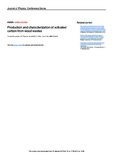Mostrar el registro sencillo del ítem
Production and characterization of activated carbon from wood wastes
| dc.creator | Ramirez A.P., Giraldo S., Ulloa M., Flórez E., Acelas N.Y. | spa |
| dc.date.accessioned | 2018-04-13T16:34:32Z | |
| dc.date.available | 2018-04-13T16:34:32Z | |
| dc.date.created | 2017 | |
| dc.identifier.issn | 17426588 | |
| dc.identifier.uri | http://hdl.handle.net/11407/4565 | |
| dc.description.abstract | Cedarwood (Cedrela Angustifolia) and teak (Tectona Grandis) woods are typically used for furniture manufacture because they have high durability, are light and easy to work. During these manufacturing process, large amount of these wastes is generated causing disposal environmental problems. In this paper, the residual wastes (sawdust) of Cedar (C) and Teak (T) are transformed into an activated material. The chemical composition of both biomass (C and T) was determinate by TGA (Thermogravimetric Analysis). Activated materials were characterized in surface area following the BET (Brunauer, Emmett and Teller) method, morphology using SEM (Scanning Electron Microscopy) and to know their functional groups a FTIR (Fourier Transform Infrared Spectroscopy) analysis was done. Their adsorption capacity was evaluated by removal of Methylene Blue (MB) and Congo Red (CR) from aqueous solutions. © Published under licence by IOP Publishing Ltd. | eng |
| dc.language.iso | eng | |
| dc.publisher | Institute of Physics Publishing | spa |
| dc.relation.isversionof | https://www.scopus.com/inward/record.uri?eid=2-s2.0-85041483989&doi=10.1088%2f1742-6596%2f935%2f1%2f012012&partnerID=40&md5=fb7b73620331bc38a939dd98c662a58d | spa |
| dc.source | Scopus | spa |
| dc.title | Production and characterization of activated carbon from wood wastes | spa |
| dc.type | Conference Paper | eng |
| dc.rights.accessrights | info:eu-repo/semantics/restrictedAccess | |
| dc.contributor.affiliation | Universidad de Medellin, Medellin, Colombia | spa |
| dc.identifier.doi | 10.1088/1742-6596/935/1/012012 | |
| dc.subject.keyword | Activated carbon; Adsorption; Aromatic compounds; Azo dyes; Carbon; Characterization; Chemical analysis; Dyes; Fourier transform infrared spectroscopy; Furniture manufacture; Manufacture; Scanning electron microscopy; Solutions; Waste disposal; Activated materials; Adsorption capacities; Chemical compositions; Environmental problems; High durability; Manufacturing process; Residual wastes; Tectona grandis; Thermogravimetric analysis | eng |
| dc.publisher.faculty | Facultad de Ciencias Básicas | spa |
| dc.abstract | Cedarwood (Cedrela Angustifolia) and teak (Tectona Grandis) woods are typically used for furniture manufacture because they have high durability, are light and easy to work. During these manufacturing process, large amount of these wastes is generated causing disposal environmental problems. In this paper, the residual wastes (sawdust) of Cedar (C) and Teak (T) are transformed into an activated material. The chemical composition of both biomass (C and T) was determinate by TGA (Thermogravimetric Analysis). Activated materials were characterized in surface area following the BET (Brunauer, Emmett and Teller) method, morphology using SEM (Scanning Electron Microscopy) and to know their functional groups a FTIR (Fourier Transform Infrared Spectroscopy) analysis was done. Their adsorption capacity was evaluated by removal of Methylene Blue (MB) and Congo Red (CR) from aqueous solutions. © Published under licence by IOP Publishing Ltd. | eng |
| dc.creator.affiliation | Ramirez, A.P., Universidad de Medellin, Medellin, Colombia; Giraldo, S., Universidad de Medellin, Medellin, Colombia; Ulloa, M., Universidad de Medellin, Medellin, Colombia; Flórez, E., Universidad de Medellin, Medellin, Colombia; Acelas, N.Y., Universidad de Medellin, Medellin, Colombia | spa |
| dc.relation.ispartofes | Journal of Physics: Conference Series | spa |
| dc.relation.references | Petroleum, B., (2007) BP Statistical Review of World Energy, 66. , London: BP Energy; Ramirez, A., (2017) Rev. Colomb. Quím., 46 (1), pp. 33-41; Zhang, Z., (2015) J. Taiwan. Inst. Chem. Eng., 49, pp. 206-211; Botomé, M., (2017) Chem. Eng. J., 321, pp. 614-621; López, F., (2013) J. Anal. Appl. Pyrolysis, 104, pp. 551-558; Department, F., (1990) Energy Conservation in the Mechanical Forest Industries, , (Italy: Food and agriculture organization of the united nations) chapter 6; Li, Y., (2011) Appl. Surf. Sci., 257 (24), pp. 10621-10627; Nieto, C., Terrones, M., Rangel, J., (2011) Biomass Bioenergy, 35 (1), pp. 103-112; Ahmadpour, A., Do, D., (1996) Carbon, 34 (4), pp. 471-479; Mudoga, H., Yucel, H., Kincal, N., (2008) Bioresour. Technol., 99 (9), pp. 3528-3533; Gañán, J., (2006) Appl. Surf. Sci., 252 (17), pp. 5976-5979; Ojr, P., (2014) Ind. Eng. Chem. Res., 20 (6), pp. 4401-4407; Ahmed, M., Dhedan, S., (2012) Fluid Phase Equilib., 317, pp. 9-14; Luna, D., (2007) ContactoS, 64, pp. 39-48; Islam, M., (2015) J. Taiwan. Inst. Chem. Eng., 52, pp. 57-64; Yorgun, S., Yildiz, D., (2015) J. Taiwan. Inst. Chem. Eng., 53, pp. 122-131; Thue, P., (2016) J. Mol. Liq., 223, pp. 1067-1080; Vimonses, V., (2009) Chem. Eng. J., 148 (2-3), pp. 354-364; Mall, I., (2005) Chemosphere, 61 (4), pp. 492-501 | spa |
| dc.type.version | info:eu-repo/semantics/publishedVersion | |
| dc.type.driver | info:eu-repo/semantics/conferenceObject |
Ficheros en el ítem
Este ítem aparece en la(s) siguiente(s) colección(ones)
-
Indexados Scopus [1632]

